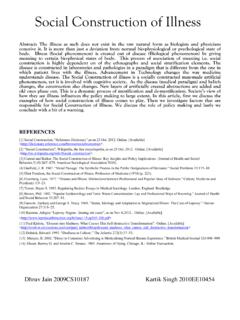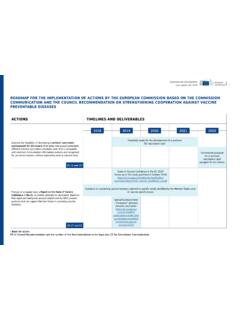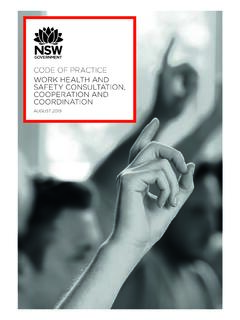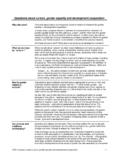Transcription of Studying Cooperation and Conflict between Authors with ...
1 Studying Cooperation and Conflict between Authors with history flow Visualizations Fernanda B. Vi gas Martin Wattenberg Kushal Dave MIT Media Lab Cambridge, MA 02139 USA IBM Research Cambridge, MA 02142 USA IBM Research Cambridge, MA 02142 USA ABSTRACT The Internet has fostered an unconventional and powerful style of collaboration: wiki web sites, where every visitor has the power to become an editor. In this paper we investigate the dynamics of Wikipedia, a prominent, thriving wiki. We make three contributions. First, we introduce a new exploratory data analysis tool, the history flow visualization, which is effective in revealing patterns within the wiki context and which we believe will be useful in other collaborative situations as well.
2 Second, we discuss several collaboration patterns highlighted by this visualization tool and corroborate them with statistical analysis. Third, we discuss the implications of these patterns for the design and governance of online collaborative social spaces. We focus on the relevance of authorship, the value of community surveillance in ameliorating antisocial behavior, and how Authors with competing perspectives negotiate their differences. Categories & Subject Descriptors : GUI; :n Collaborative computing, Web- based interaction. Keywords Wiki, revision history, visualization, collaboration, document INTRODUCTION Online communities have long allowed people with conflicting perspectives and values to meet and talk but usually without any need to resolve their differences.
3 Indeed, given the endless arguments often found in traditional online forums, asking that a large group reach consensus online may seem impossible. In recent years, however, new online technologies have arisen that, by their nature, favor consensus building by community members. One example of such a technology is a special kind of web site known as a wiki. Invented in 1995 by Ward Cunningham [14][9], a defining feature is that any reader of the site may also be an author. Each page has an edit this page link at the bottom, allowing users to change the content of the page. This interface supports a higher level of consensus building because a user who disagrees with a statement can very easily delete it.
4 In this sense, the text on wiki pages is content that has survived the critical eye of the community. Since Cunningham s original implementation, wikis have become popular for many purposes both public and private, ranging from knowledge management to education [1][5]. This paper is an examination of the largest public wiki, (or simply Wikipedia ), which is a thriving site despite a seemingly unlikely model for success. The founders of Wikipedia wished to create a free online encyclopedia. Rejecting the traditional method of having each article written by an expert and subjected to review, fact-checking and editing, they took the opposite tack: on Wikipedia, content can be added or changed at any time by anyone on the Internet.
5 To many, this approach so vulnerable to mistakes, ignorance and malice seems a flatly ridiculous way of producing a serious reference tool. The mystery of Wikipedia is that despite the obvious potential drawbacks of its openness, it has enjoyed significant success. It currently contains articles on more than 100,000 subjects, and from July 2002 to July 2003, it averaged 150,000 page views and 3,300 edits per day [18]. It has attracted many writers, but more importantly many readers, suggesting that the articles are worth reading. In this paper, we describe our investigation into how and why such an open and vulnerable system works. Wikipedia generously makes public its database of articles, along with all past revisions of those articles, providing a rich record of interactions between Authors .
6 Mining this vast data set is a challenge: to tackle it, we created a new visualization method, dubbed history flow, designed to show relationships between multiple document versions. Exploratory analysis with this visualization revealed complex patterns of Cooperation and Conflict . We also describe some initial statistical corroboration for the patterns we find. Finally, we propose several hypotheses based on these analyses for how and why this collective authoring environment succeeds. Our chief conclusion is that Wikipedia and its audience must be viewed as a system in which constant change is a source of strength as well as weakness. The site is subject to frequent vandalism and inaccuracy, just as skeptics might suspect but the active Wikipedia community rapidly and effectively repairs most damage.
7 Indeed, one type of Permission to make digital or hard copies of all or part of this work forpersonal or classroom use is granted without fee provided that copies arenot made or distributed for profit or commercial advantage and thatcopies bear this notice and the full citation on the first page. To copyotherwise, or republish, to post on servers or to redistribute to lists,requires prior specific permission and/or a fee. CHI 2004, April 24 29, 2004, Vienna, Austria. Copyright 2004 ACM 1-58113-702-8/04 $ CHI 2004 Paper 24-29 April Vienna, Austria Volume 6, Number 1 575malicious edit we examined is typically repaired within two minutes.
8 Similarly, while rapid content changes mean entries do not have the stability of a print encyclopedia, it also means that entries can take into account relevant news events. We believe such dynamic properties are both interesting in themselves and have implications for the design of other online communities where collaboration and consensus are critical. Wikipedia history Wikipedia was launched on January 15, 2001. It began as an experimental project related to an earlier encyclopedia site called Nupedia [11]. Nupedia took the conventional approach to encyclopedic writing: articles were written by an expert and approved only after a long review process, fact-checking and editing.
9 Wikipedia instead leveraged the freeform style of interaction developed by Ward Cunningham. While Wikipedia s content grew rapidly, Nupedia s progress has been slow in the period from October 2001 to April 2003, it released only two new articles [12]. Wiki technology Wikis rely on server-side technology that allows visitors to make instant updates to a web page via a web interface. Every editable1 page on a wiki site has an edit this page link that visitors can use to alter the contents of the page. Clicking on this link navigates to an editing view with a text field containing the page s contents. The user can edit this text and submit a new version, which will immediately replace the previous one.
10 Editing itself is quite lightweight, using simple markups that are translated into HTML. It is similarly easy to create new pages and new links. In many wikis, including Wikipedia, users have the option of either registering or remaining anonymous. Registered users retain their profile whenever they come back to the site and their changes are logged under their usernames. When anonymous users edit pages, their changes are logged with their IP address. Most wikis (including Wikipedia) have archiving systems that record all previous edits of a page and make it simple to revert to an earlier version. If the ease of adding a contribution is a distinguishing feature of a wiki, so too, paradoxically, is the ease of removing contributions of others by reverting an edit.









